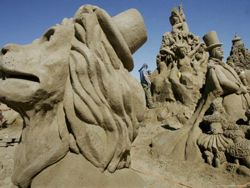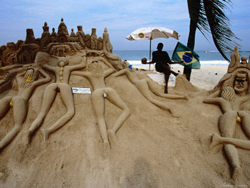
The Wonderful Art World of Sand Sculpting
The Wonderful Art World of Sand Sculpting
Whether it is a child on the beach creating a sand castle or a group of professional sand sculptors replicating a famous landmark, the end result is always a work of art. To admire the fantasy and beauty of sand sculpture art, take a look at these photographs.
Sand sculpting is an art form, as it requires the individual’s creativity and imagination. Like in all other styles of art, the artist must have skill, patience and lots of practice in order to improve his or her work. Eventually, even with the use of simple tools, awesome showpieces will emerge.
practice in order to improve his or her work. Eventually, even with the use of simple tools, awesome showpieces will emerge.
The Where and How of Sand Sculpting
Sand sculpture is typically carried out on a beach, in a sandpit, or wherever there is an abundance of sand and water. Before the project is started, it is important to find an ideal area on the beach - a location that is just above the high tide line where the sand is dark and wet. To ensure that the sand is of sculpting quality, take a handful and squeeze it into a ball, and if it does not maintain its form, then the sand is too dry to hold the desired shape of the structure. A site too close to the tide line will quickly destroy the sculpture.
Tools for Sand Sculpting
Almost anything can be used as a building instrument in sand sculpting. Some create remarkable sand sculptures using spatulas, spoons, knives, forks, brushes, blowpipes, sticks, chisels, and other commonplace objects, while others choose to work with the more sophisticated sand sculpting tools. The shovel is perhaps the most useful instrument as it is needed to dig the sculpture’s foundation and move sand around. Other important tools are a bucket of water and a spray bottle; the sculpture must stay moist during production in order to prevent it from crumbling. However, as in most other art forms, the hands are the most important tool - they pat down and shape the sand sculpture to its desired appearance.
General Tips for Sand Sculpting
The only limit to sand sculptures is the imagination. Note the following tips and have fun.
• When stumped, take a break, since working while frustrated can lead to demoralizing results.
• Be prepared, have your tools handy, and create an  outline that shows in advance what you want your sculpture to look like.
outline that shows in advance what you want your sculpture to look like.
• When digging the foundation for the sculpture, make sure that you do it in wet sand. The bottom should be moist, otherwise find a different location.
• For the sculpture’s major structures, have a form, such as a bottomless garbage can or wooden box that can hold wet sand. It should be placed on the level foundation and the base gently tapped to create a new part of the sculpture.
• Finally, when the rough sculpture is completed, remove any excess sand and create carvings until the spectacular showpiece emerges.
The Popularity of Sand Sculpting Today
Nowadays, sand sculpting has become increasingly popular, as there are now companies in the United States that will create enormous sand sculptures for corporations and private clients all over the world. There are also many sand sculpting competitions that take place every year, whereby the subject matter goes well beyond the basic sand castle; instead, complex and sophisticated structures are typically attempted and some end up being works of art. In 2007, Ed Jarrett made the record books at Point Sebago Resort in Casco, Maine when he completed his “Castle to the Sun,” which was 31.7 feet high.
The amount of effort and attention to detail that is required to create a sand sculpture is unmatched. Art lovers everywhere have come to appreciate this art form and rightly bestow on it the recognition it deserves.
Donovan Gauvreau
Art Historian, Donovan Gauvreau lectures about art therapy with a focus on creativity development. He believes we can learn from the great masters in art to communicate ideas and feelings through painting. He provides content for www.AaronArtPrints.org to educate and inspire people to take a glimpse into an artist's life to better understand the meaning behind their work.












